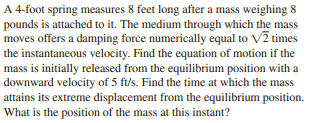A 4-foot spring measures 8 feet long after a mass weighing 8 pounds is attached to it. The medium through which the mass moves offers a damping force numerically equal to V2 times the instantaneous velocity. Find the equation of motion if the mass is initially released from the equilibrium position with a downward velocity of 5 ft/s. Find the time at which the mass attains its extreme displacement from the equilibrium position. What is the position of the mass at this instant?
A 4-foot spring measures 8 feet long after a mass weighing 8 pounds is attached to it. The medium through which the mass moves offers a damping force numerically equal to V2 times the instantaneous velocity. Find the equation of motion if the mass is initially released from the equilibrium position with a downward velocity of 5 ft/s. Find the time at which the mass attains its extreme displacement from the equilibrium position. What is the position of the mass at this instant?
Calculus: Early Transcendentals
8th Edition
ISBN:9781285741550
Author:James Stewart
Publisher:James Stewart
Chapter1: Functions And Models
Section: Chapter Questions
Problem 1RCC: (a) What is a function? What are its domain and range? (b) What is the graph of a function? (c) How...
Related questions
Question
Your solution should show:
- A diagrammatic sketch of the problem, properly labeled with the relevant variables, with a listing of the given information, and the quantities asked/to be determined.
- The initial-value problem
- Details on the setting up of the IVP beginning with Newton's 2nd Law of Motion, with specified assumptions
- Details on the solution of the IVP
- Plot of the solution [equation of motion, x(t)]
- Summary: The IVP and the answers to questions/required items.

Transcribed Image Text:A 4-foot spring measures 8 feet long after a mass weighing 8
pounds is attached to it. The medium through which the mass
moves offers a damping force numerically equal to V2 times
the instantaneous velocity. Find the equation of motion if the
mass is initially released from the equilibrium position with a
downward velocity of 5 ft/s. Find the time at which the mass
attains its extreme displacement from the equilibrium position.
What is the position of the mass at this instant?
Expert Solution
This question has been solved!
Explore an expertly crafted, step-by-step solution for a thorough understanding of key concepts.
This is a popular solution!
Trending now
This is a popular solution!
Step by step
Solved in 5 steps with 5 images

Recommended textbooks for you

Calculus: Early Transcendentals
Calculus
ISBN:
9781285741550
Author:
James Stewart
Publisher:
Cengage Learning

Thomas' Calculus (14th Edition)
Calculus
ISBN:
9780134438986
Author:
Joel R. Hass, Christopher E. Heil, Maurice D. Weir
Publisher:
PEARSON

Calculus: Early Transcendentals (3rd Edition)
Calculus
ISBN:
9780134763644
Author:
William L. Briggs, Lyle Cochran, Bernard Gillett, Eric Schulz
Publisher:
PEARSON

Calculus: Early Transcendentals
Calculus
ISBN:
9781285741550
Author:
James Stewart
Publisher:
Cengage Learning

Thomas' Calculus (14th Edition)
Calculus
ISBN:
9780134438986
Author:
Joel R. Hass, Christopher E. Heil, Maurice D. Weir
Publisher:
PEARSON

Calculus: Early Transcendentals (3rd Edition)
Calculus
ISBN:
9780134763644
Author:
William L. Briggs, Lyle Cochran, Bernard Gillett, Eric Schulz
Publisher:
PEARSON

Calculus: Early Transcendentals
Calculus
ISBN:
9781319050740
Author:
Jon Rogawski, Colin Adams, Robert Franzosa
Publisher:
W. H. Freeman


Calculus: Early Transcendental Functions
Calculus
ISBN:
9781337552516
Author:
Ron Larson, Bruce H. Edwards
Publisher:
Cengage Learning